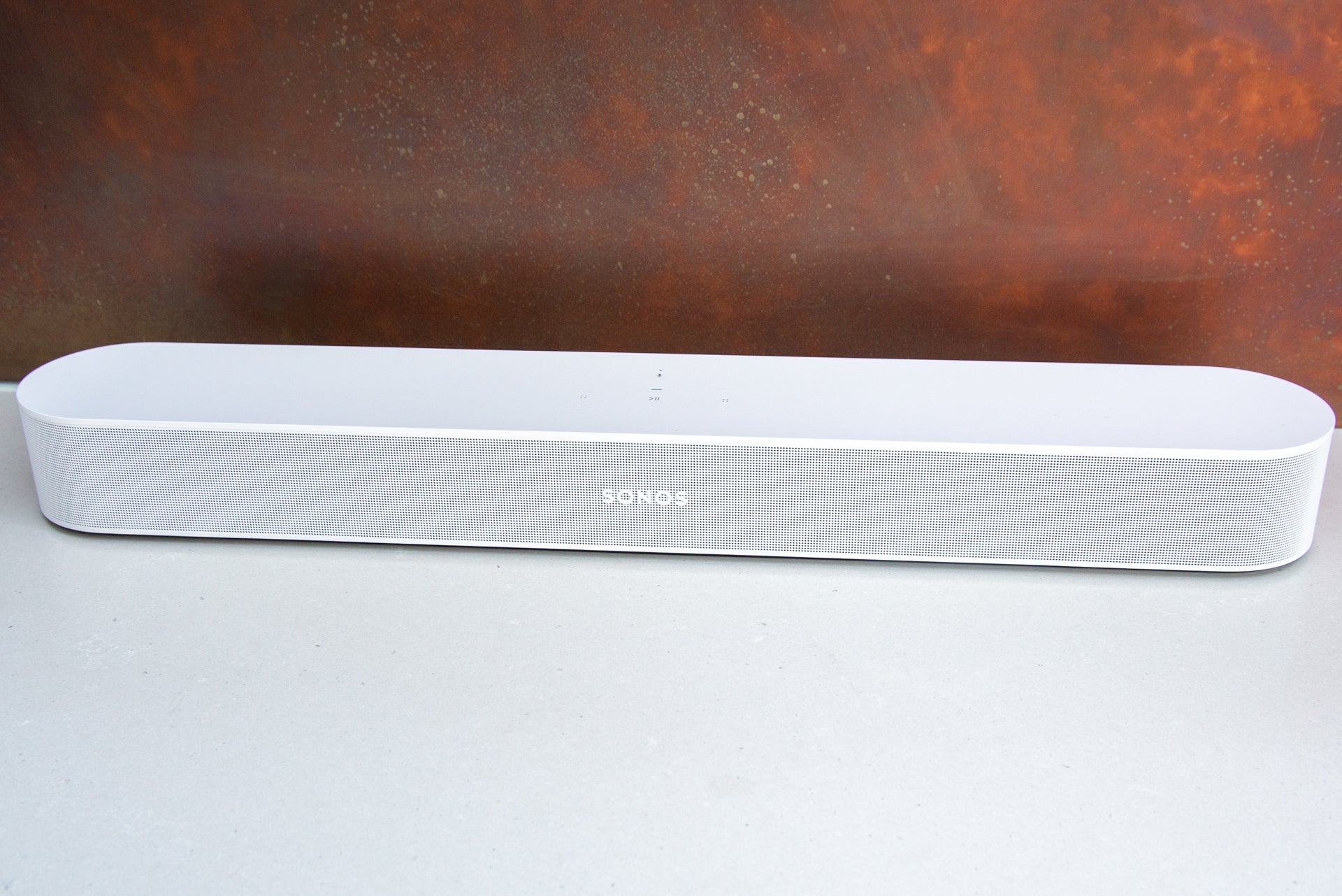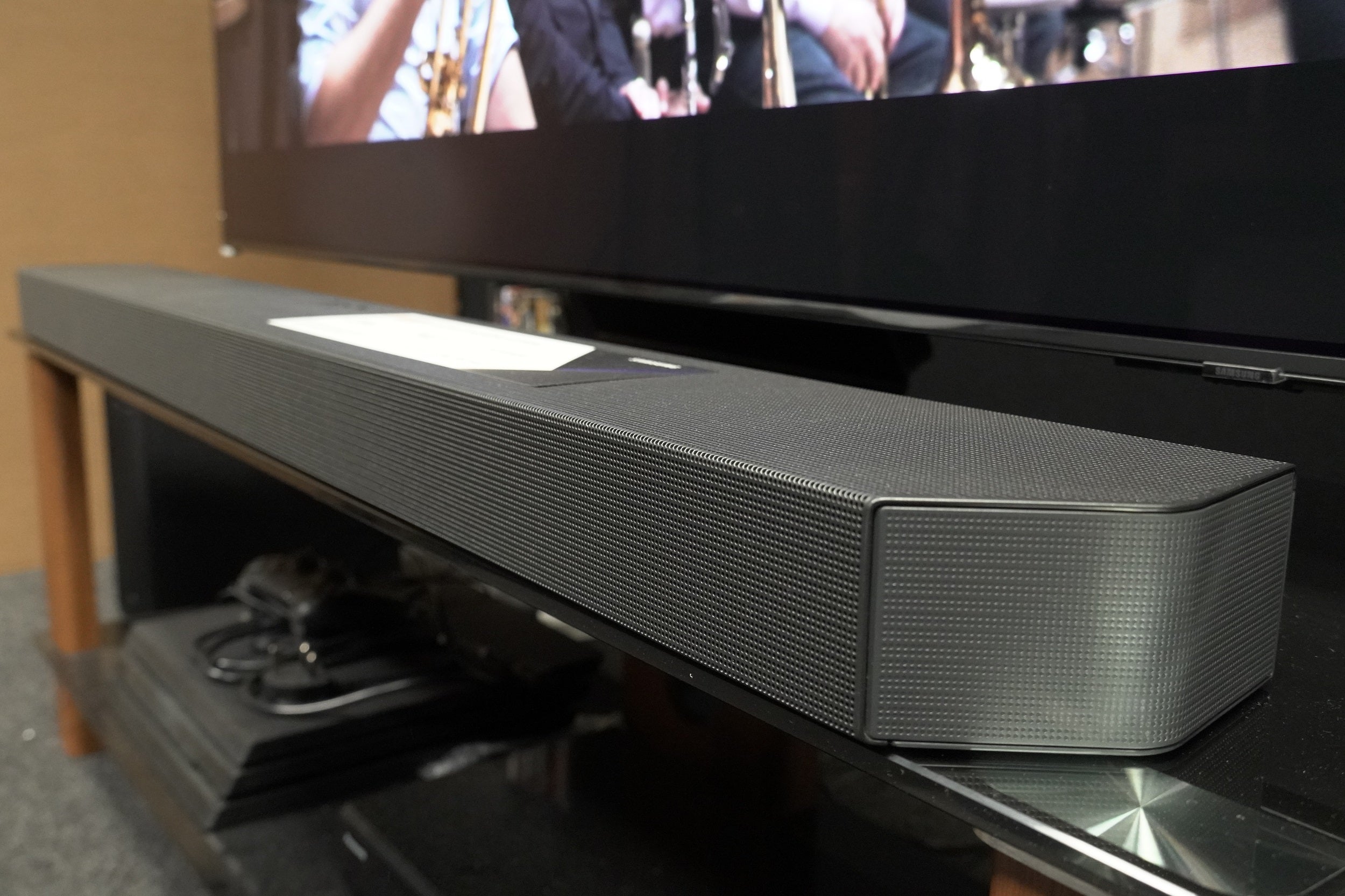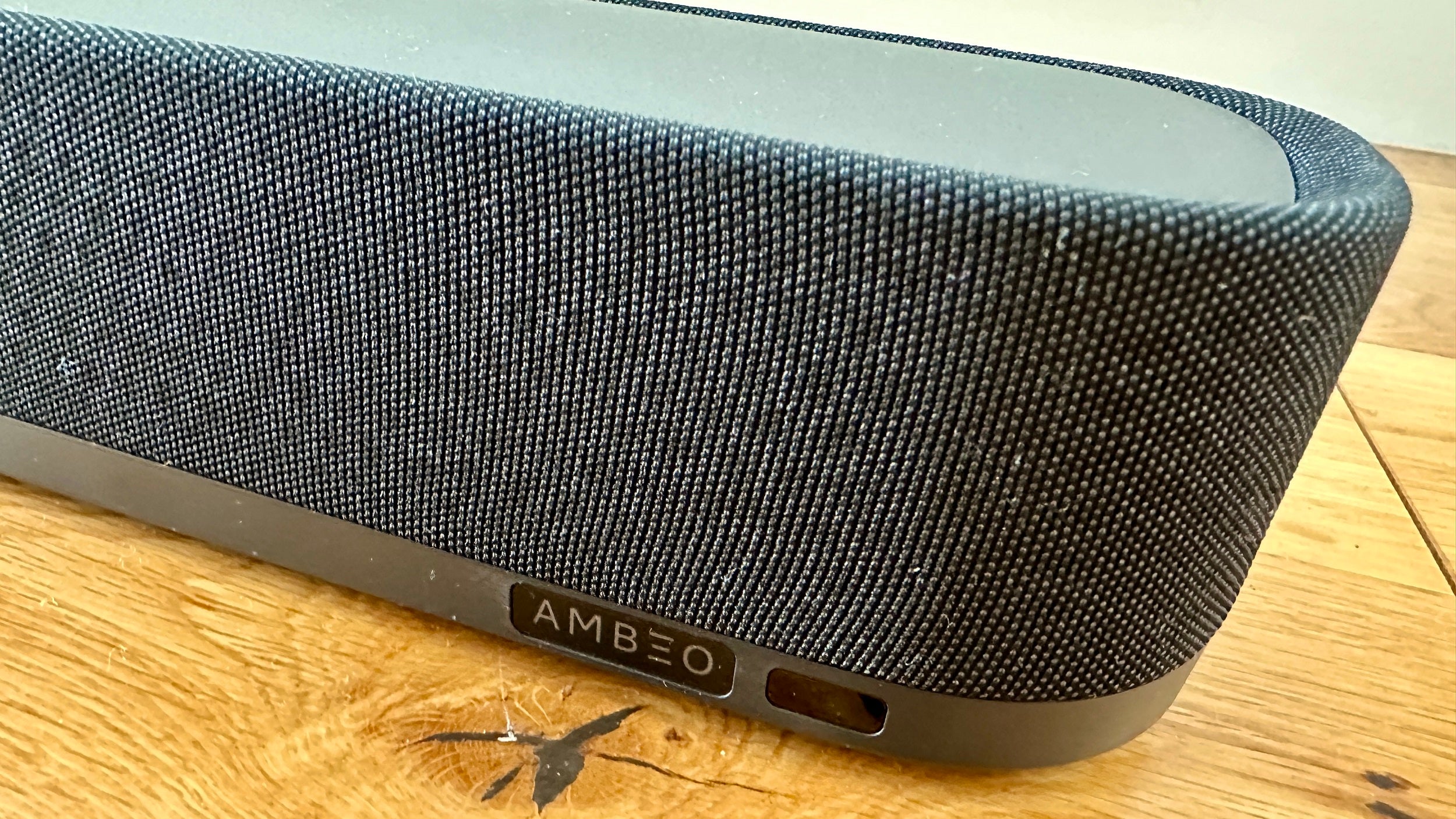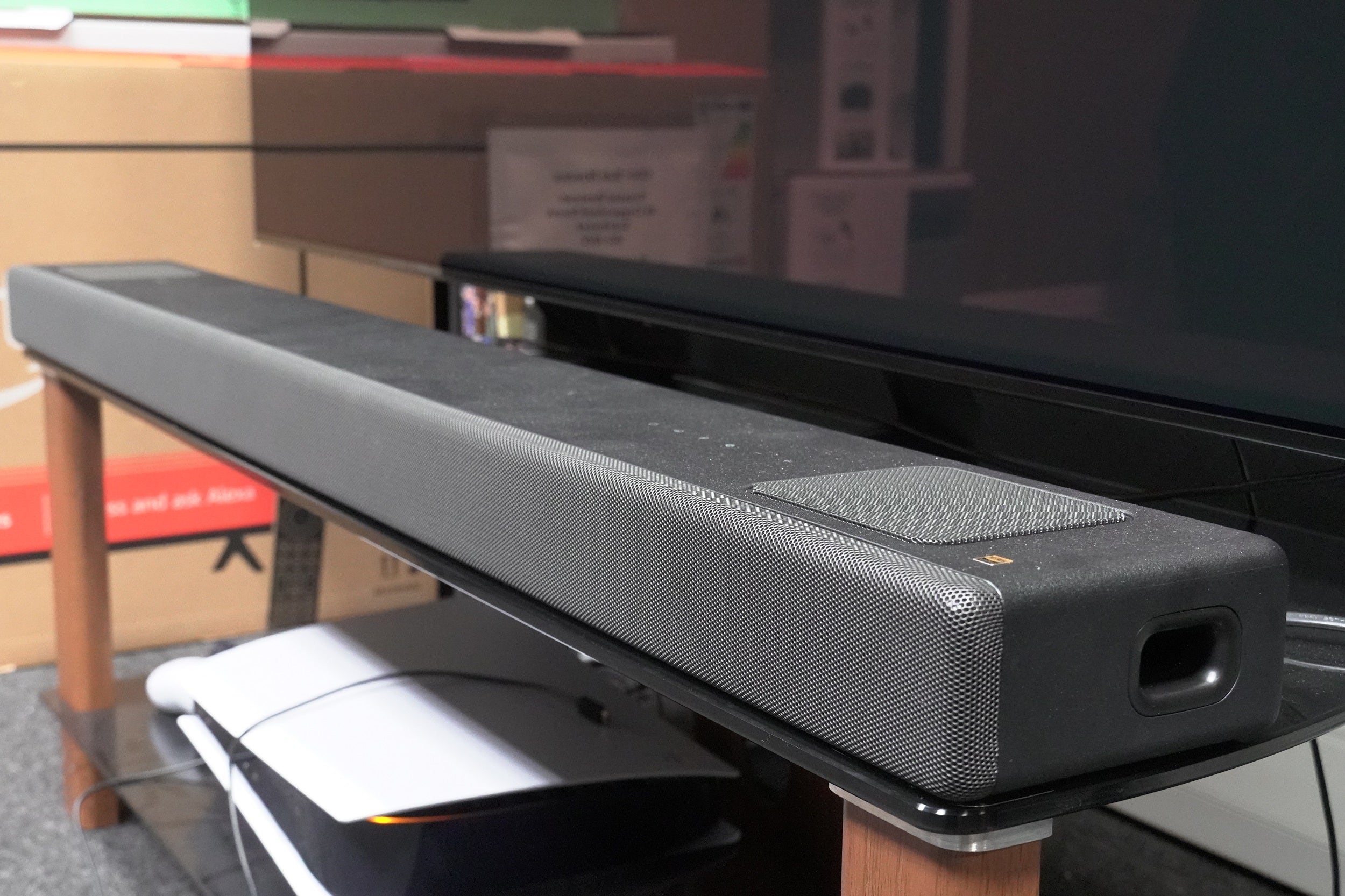Samsung HW-Q800C Review
A blockbuster of a home cinema soundbar from Samsung
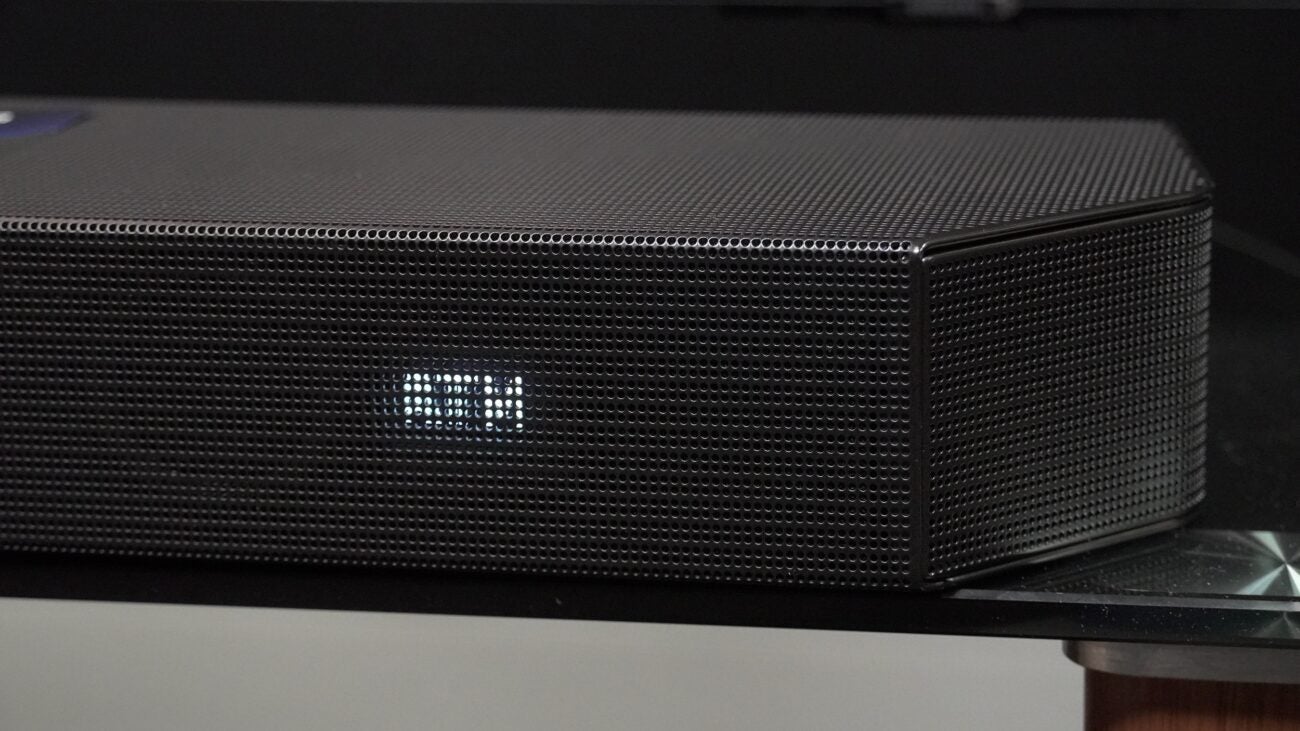


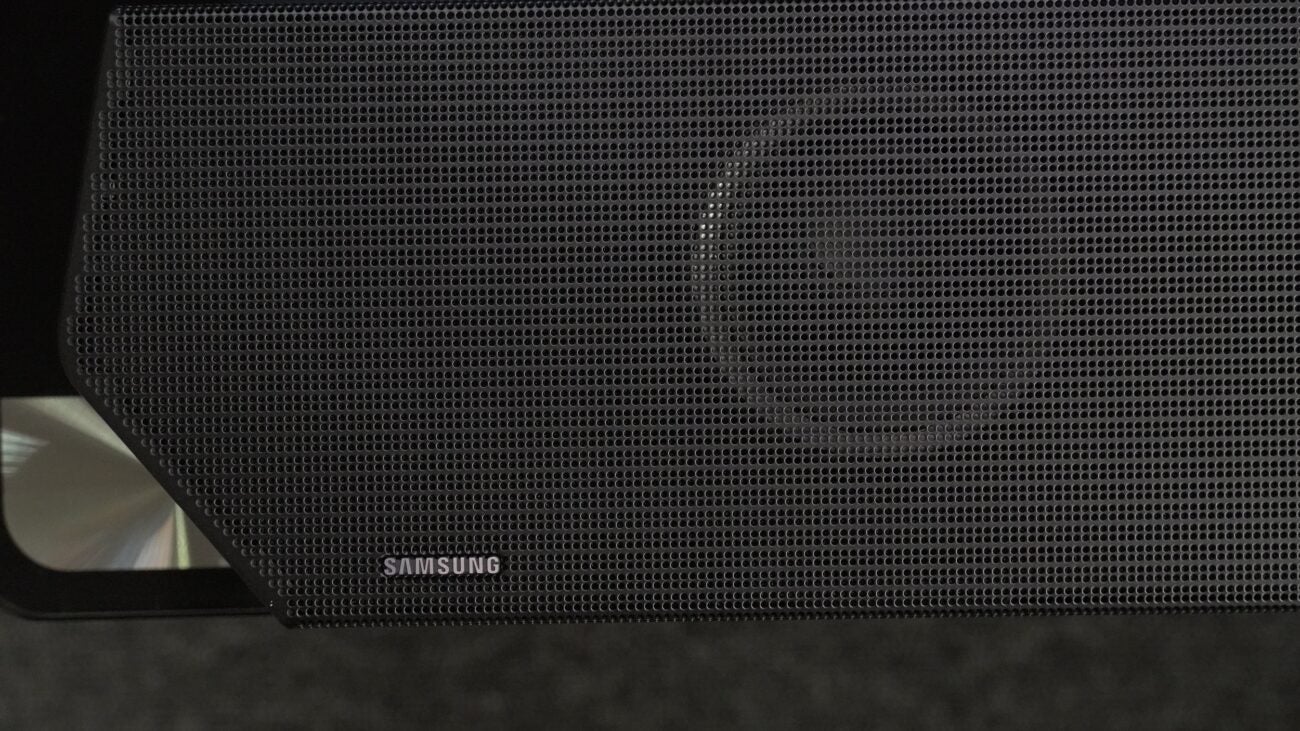

Verdict
The Samsung HW-Q800C is another convincing, powerful, and satisfying immersive soundbar from Samsung with better bass performance than its predecessor. If you have a recent Samsung QLED or OLED TV, this is a fire-cracker of a soundbar to partner with.
Pros
- Big, powerful audio performance
- Excellent dialogue reproduction
- Muscular but controlled bass performance
- Good with music
Cons
- No Chromecast support
- A little too close to HW-Q930C in price
Key Features
- Wireless Dolby AtmosStream Dolby Atmos audio wirelessly from Samsung TV to soundbar
- SpaceFit Sound ProCalibrates the soundbar’s sound for your room
- AlexaAmazon’s voice assistant is built-in
Introduction
Samsung has been the market king of TVs for well over a decade and has had a similarly long run with its soundbars. The HW-Q800C shows it’s in no interest of letting its crown slip.
Sandwiched between the Q930C and step-down Q700C Q-series soundbars, the HW-Q800C is a soundbar and subwoofer combo, with 5.1.2 channels of sound to deliver immersive audio from Dolby Atmos and DTS:X soundtracks.
The HW-Q700C was very good, and I’m pleased to say the Samsung Q800C is even better. Here’s my full review.
Design
- Anonymous appearance
- Best suited to 55-inch TVs and bigger
- Massive subwoofer
Like with its TVs, Samsung has converged on a homogenous design for its 2023 soundbar line-up. This is another big, angular slab of soundbar design that at the same time doesn’t want to hog attention from the images on the TV above it.
It’s over a metre wide and as such is best suited to 55-inch TVs and bigger. In fact, it has the same dimensions as the HW-Q700C but weighs more – 5.1kg for the main unit and 9.8kg for the gigantic subwoofer. Wall-mount brackets are included for those who want to hang the main bar on a wall.
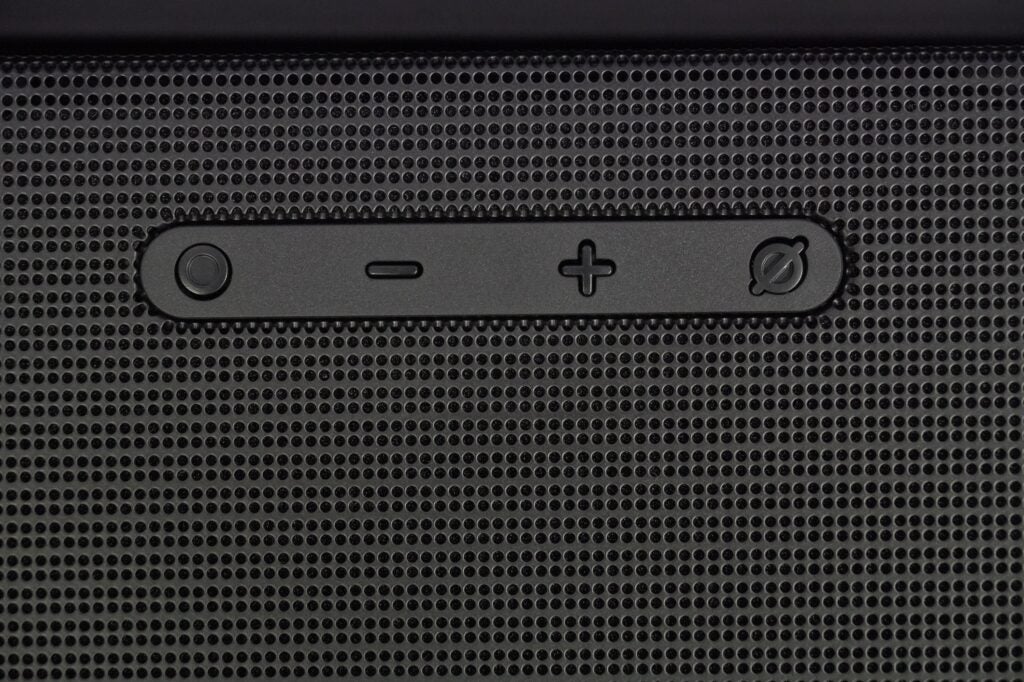
Physical inputs are on top and cover power, volume, and source input, which are all repeated on the elegant One Remote Control that features more buttons for Bluetooth pairing, navigation, and settings. Underneath the bar is a recessed area with HDMI eARC out to a TV, HDMI input, and digital optical input for older non-HDMI TVs.
You’ll find the LED display concealed behind the grille on the right-hand side, and it flags when a Dolby Atmos soundtrack is fed to the soundbar but won’t repeat the favour for DTS:X. That continues to strike me as odd.
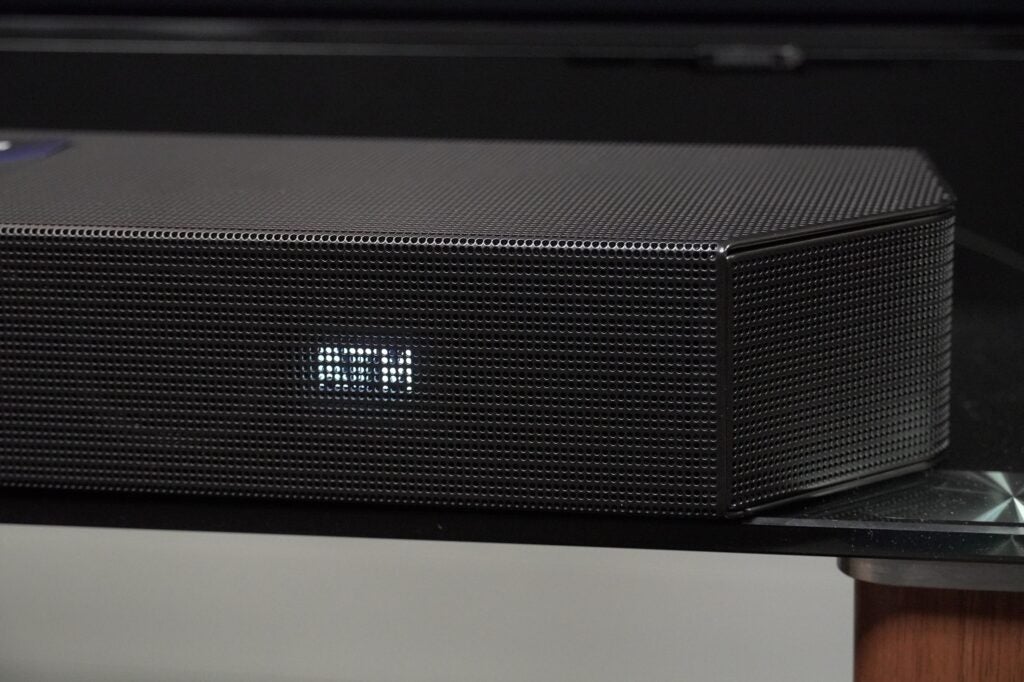
At either end of the bar are the upfiring drive units, as well as the side-firing speakers, so you’ll want to keep these areas free from blockage.
The subwoofer is something of a goliath, both wireless and rear ported. While it doesn’t need to be next to the soundbar, the preference is to place it near a wall for the best bass response.
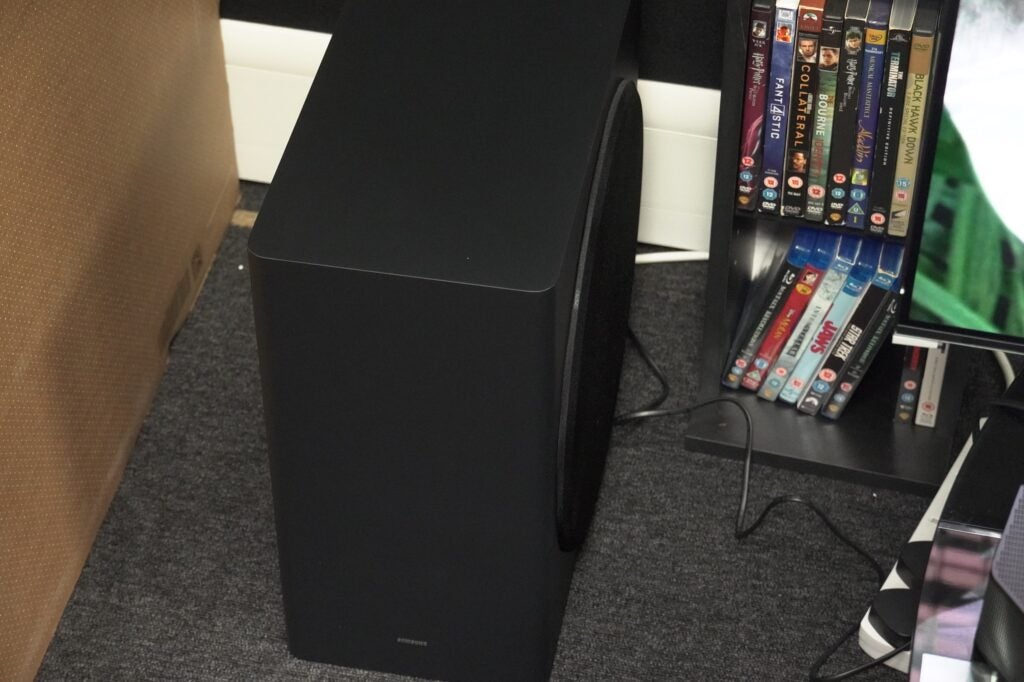
Features
- No Chromecast streaming
- Built-in Alexa support
- Range of Samsung TV specific features
Similarities between the Q700C and Q800C continue with the specification, with some upgrades and a curious downgrade. The downgrade is that there’s no Chromecast support despite its appearance on the Q700C.
Nevertheless, there’s AirPlay 2 and Spotify Connect over a Wi-Fi connection. Other means of connection include Bluetooth 5.0 (only SBC codec), and if you want to plug a source into the HDMI input, it can pass-through 4K HDR10+, although 4K / 120Hz seems off the menu for gaming. The USB port is for service use only, and if you have a Galaxy Android smartphone you can tap it on the bar and send music wirelessly.
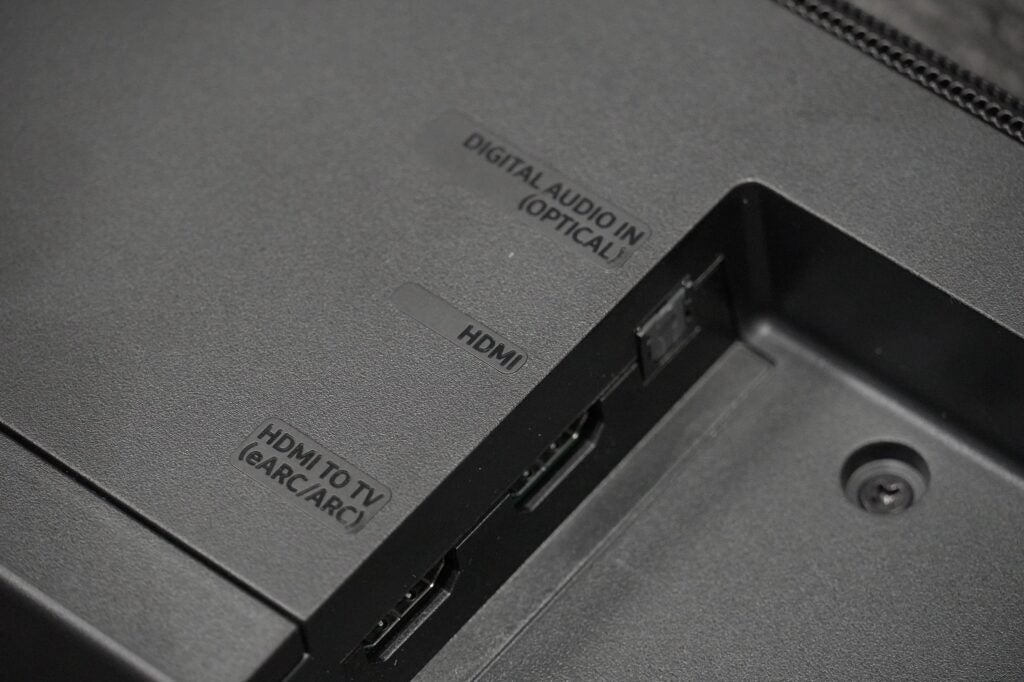
The 5.1.2 channels equate to 11 speakers, the two side-firing speakers push the count above the HW-Q700C’s 9. By adding the SWA-9200S (£199.99 / $149.99), you can increase the count even further with wireless rear speakers.
Owners of recent Samsung TVs bag exclusive features in Q-Symphony, SpaceFit Sound Pro, Active Voice Amplifier and Adaptive Sound 2.0.
Q-Symphony syncs the soundbar and TV speakers to produce a bigger sound and accurately placed dialogue and effects on screen. SpaceFit Sound Pro optimises the delivery of audio from the soundbar with a built-in microphone. Through this, Samsung claims the audio will be “perfectly calibrated” to the dimensions of your room.
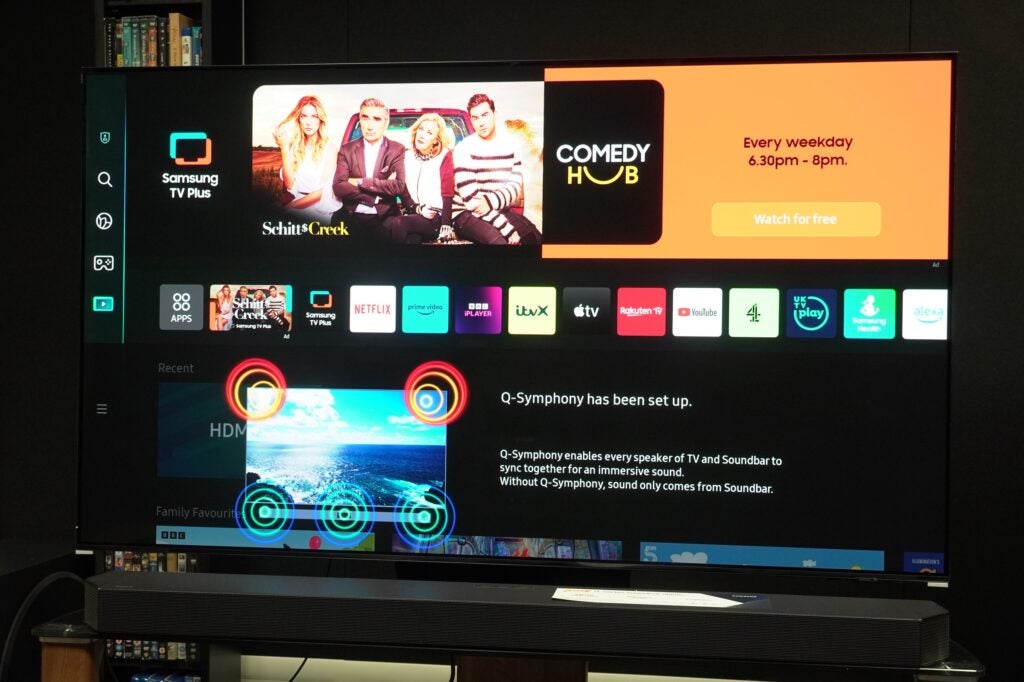
Active Voice Amplifier can detect noise in a room and raise the volume of dialogue so it’s still intelligible, while Adaptive Sound 2.0 analyses what you’re watching and adapts it using artificial intelligence. If you’re watching a programme at a low volume, Samsung says the bar will emphasise dialogue to remain audible.
Another feature is the Game Mode Pro 2.0, which is a dedicated gaming mode to increase immersion.
There are Alexa smarts, and she is built in so you can ask her to operate volume, play/pause Spotify streams and whatnot. With the soundbar set at volume 30 and standing about 8-10ft away from it, she couldn’t hear me during a loud scene from Dune, but a shuffle forward and she did. Unless you are miles away, Alexa should be able to hear your commands.
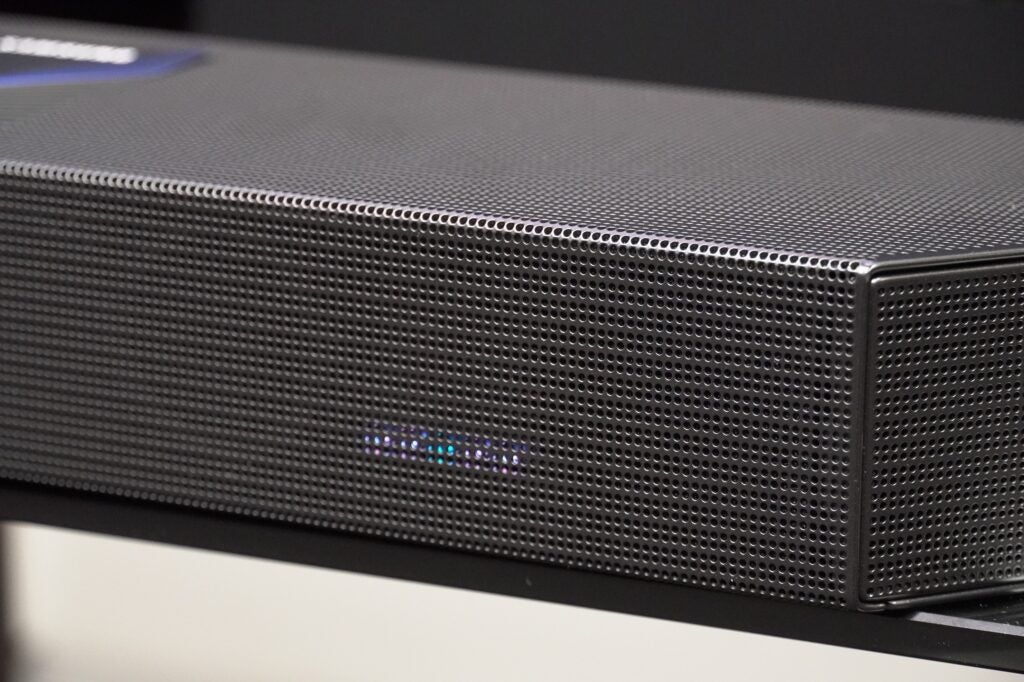
Alexa and the soundbar bond through Samsung’s SmartThings app, a useful hub for operating the bar with the ability to flick through inputs, alter the EQ, switch sound modes and control music playback. If you have other smart products in the home, it’s worth establishing whether they’re app-compatible to tie devices together.
Wireless Dolby Atmos is supported, though this isn’t supported with any TV. It’s compatible with Samsung TVs from 2022 and 2023. For whatever reason I could not enable it, as the process would always crash during setup.
When it comes to soundtracks there’s room for Dolby Atmos (Dolby TrueHD, Dolby Digital+), Dolby 5.1ch; DTS:X, DTS-HD Master Audio, DTS 5.1, DTS HD and multi-channel LPCM up to eight channels. For streaming it can decode AAC, MP3, OGG, WAV, FLAC, ALAC and AIFF, as well as Hi-Res Audio.

Sound Quality
- Expansive and powerful soundstage
- Excellent reproduction of dialogue
- Assured performance with music
The Samsung HW-Q700C is an excellent soundbar for its price, but the few qualms I had related to its lack of subtlety and slightly misaligned bass integration. Those are not issues for the Samsung HW-Q800C.
The tone of the Q800C is like the Q700C soundbar but carries more refinement, clarity, and naturalism. The ‘interlinked’ scene from Blade Runner 2049, where K goes through his baseline test, features higher levels of clarity. The unsettling ringing effect is a little sharper to reinforce that sense of discomfort.
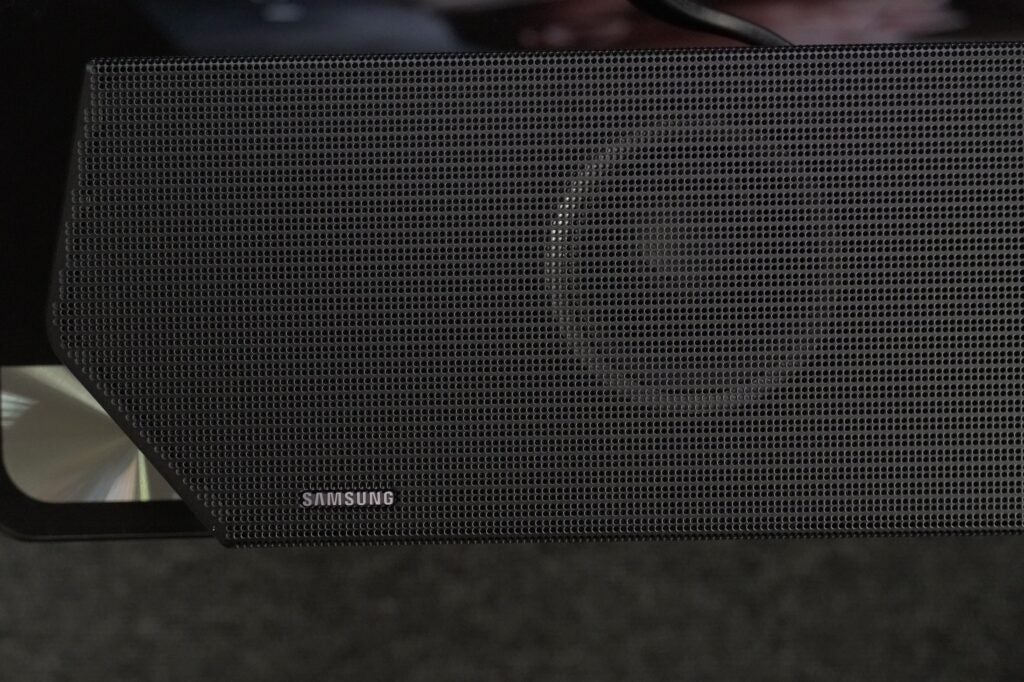
The way the soundbar projects sounds from its upfiring drivers is clearer too, the height channels in the scenes I pick from the film are better defined and have a bigger presence.
It’s a dynamic performer: lively, impactful but also controlled in handling transitions from quiet to loud and vice versa. This works well for horror moments (like the scene in Kong: Skull Island where a character happens on a massive stick insect), but also action scenes and other moments that carry force and punch – whether it’s a slow, rising progression or a scene with snappy, quick shifts, the HW-Q800C is alert and describes them naturally.
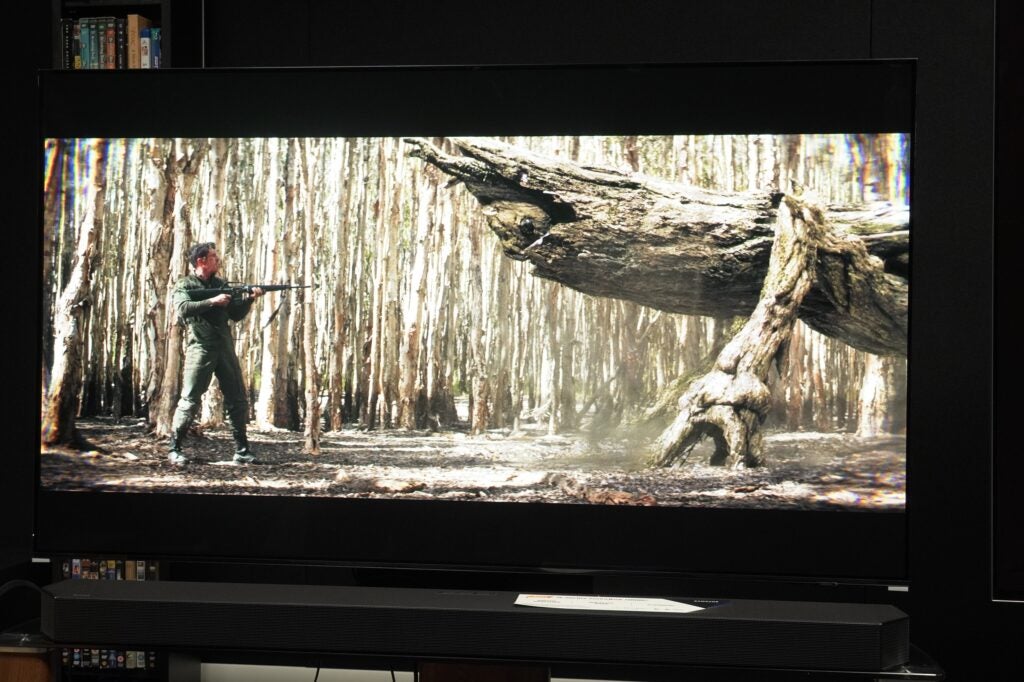
With its centre channel, reproduction of dialogue is excellent; clearer and more natural in capturing the tone of actors than the HW-Q700C. Tenet and Dune have particularly troublesome scenes and the Q800C sails through both without issue.
In general, dialogue is conveyed crisply and clearly but also with a smoothness that avoids sounding too sharp or sibilant. Engaging Voice Enhancement introduces more sharpness, and I noted sibilance from time to time, but this vocal boost works well. It doesn’t elevate other effects in the scene as much, nor raise the noise floor like the Q700C did.
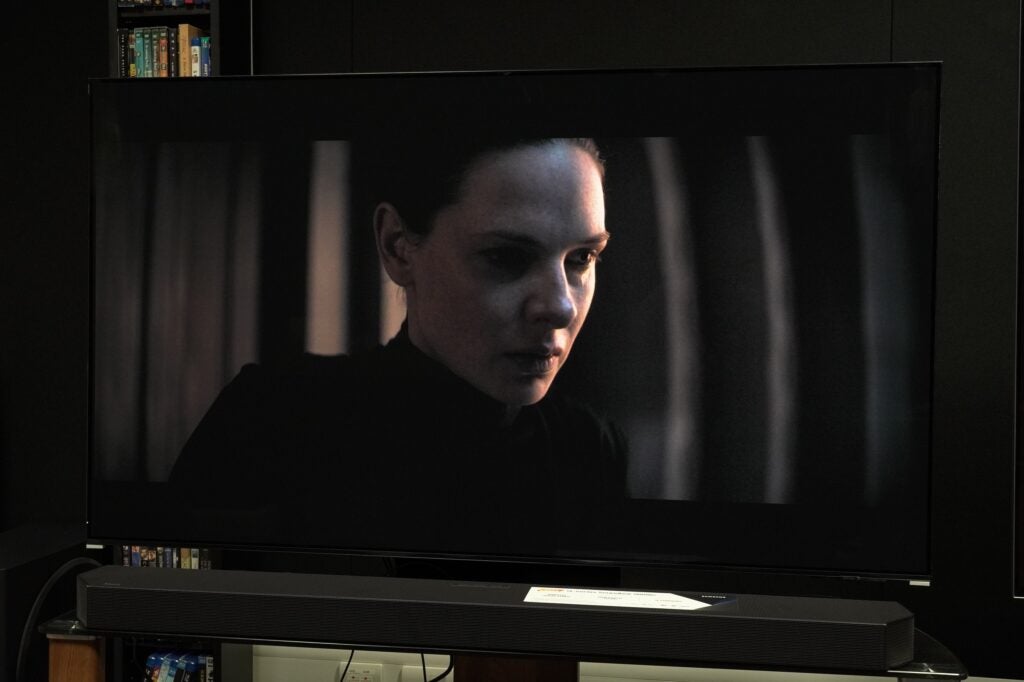
Bass and sub-bass are brilliantly managed. Dune is, again, a film that features a lot of low frequency heft (the ‘voice’ scenes are a particular favourite of mine) and the HW-Q800C is more than up to the task at handling them.
Batman vs Superman is another big bass film, the fight between the two heroes is a full-blooded encounter with lots of force and power to the blows that Batman sends Superman’s way. But there’s always a degree of control about the Q800C’s performance. It never gets too excited or overzealous.
The bass is integrated with more clarity and definition than on the Q700C, the 8-inch subwoofer doesn’t hog the focus away from what else requires attention.
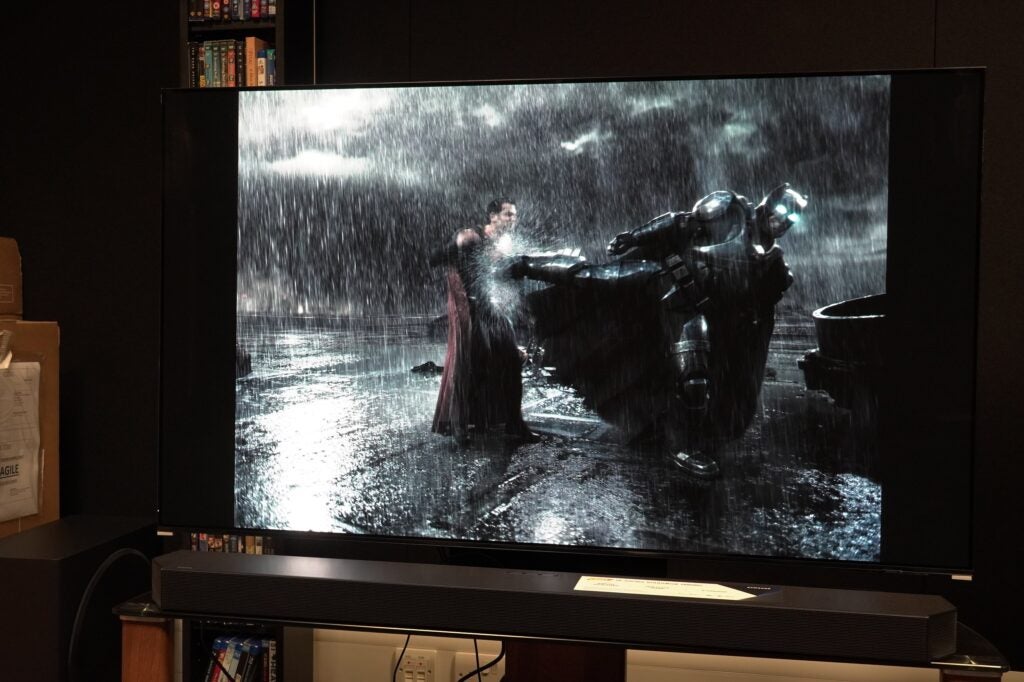
The fight between K and Sapper at the beginning of Blade Runner 2049 feels more violent, the hits are bludgeoning and eye-wincing, as good a sign as any in my book that the subwoofer is doing a good job. There’s a Bass Enhancement setting, but honestly that sounds like overkill. And in the room I test in, I never needed to go above volume 30 – 15 is perhaps the lowest you’ll want to go. Below that there’s less energy and scale to the sound.
So far it’s all been Dolby Atmos, but with DTS tracks you can expect a similar performance once the volume is raised. At the same volume, DTS:X sound is gentler and less intense. I’m not sure if it’s to do with the soundbar processing or that DTS tracks have greater headroom.
Regardless, watching Jumanji: The Next Level and dialogue is again crisp and clearly delivered, there’s good dynamic reach, and strong panning across the soundstage. The opening scenes of the film aren’t that interesting from a sound point of view, but as soon as it steps into the world of Jumanji the height and side channels become much more active. Having the side-firing speakers helps to draw you into the world.

Want more plaudits? The size and scale of this soundbar impresses too. Kong: Skull Island is full of Kaiju monsters, and with the side-firing speakers I get the sense of scale and expansion that wasn’t there with the HW-Q700C. The sound expands beyond the borders of the screen, and though this is a front-heavy soundstage, it’s a big and wide one.
When activating Q-Symphony, the dialogue feels more precise in its placement on screen, though it lacks the weight the soundbar on its own provides. The overall tone is crisper, probably because of the TV’s speakers, but some may prefer that as it elicits a little more clarity and detail to make up for the loss in weightiness.
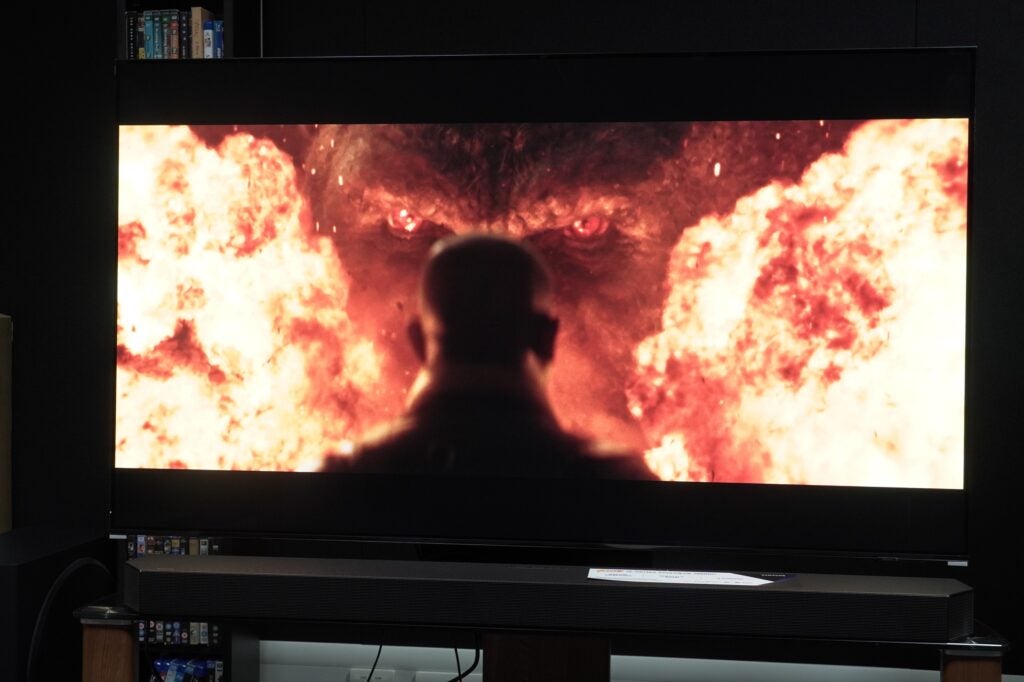
With music the Samsung HW-Q800C is an assured performer. A Spotify Connect stream is crisp, clear, and sharp, with plenty of dynamism and dynamics in evidence with a bright response in the top end of the frequency range and depth to bass. It’s better than the Bluetooth performance, which itself is no slouch, especially when Adaptive Sound is running, which gives it more focus and sharpness. I wouldn’t use the Adaptive Mode over Wi-Fi though; it doesn’t sound as good.
The two issues I have with its music performance is the slight fuzziness that can manifest in the upper midrange to highs – cymbal crashes are an example of this lack of detail. The other is that, like with movies, there’s no need to go above volume 30 as it becomes excessively big and loud.
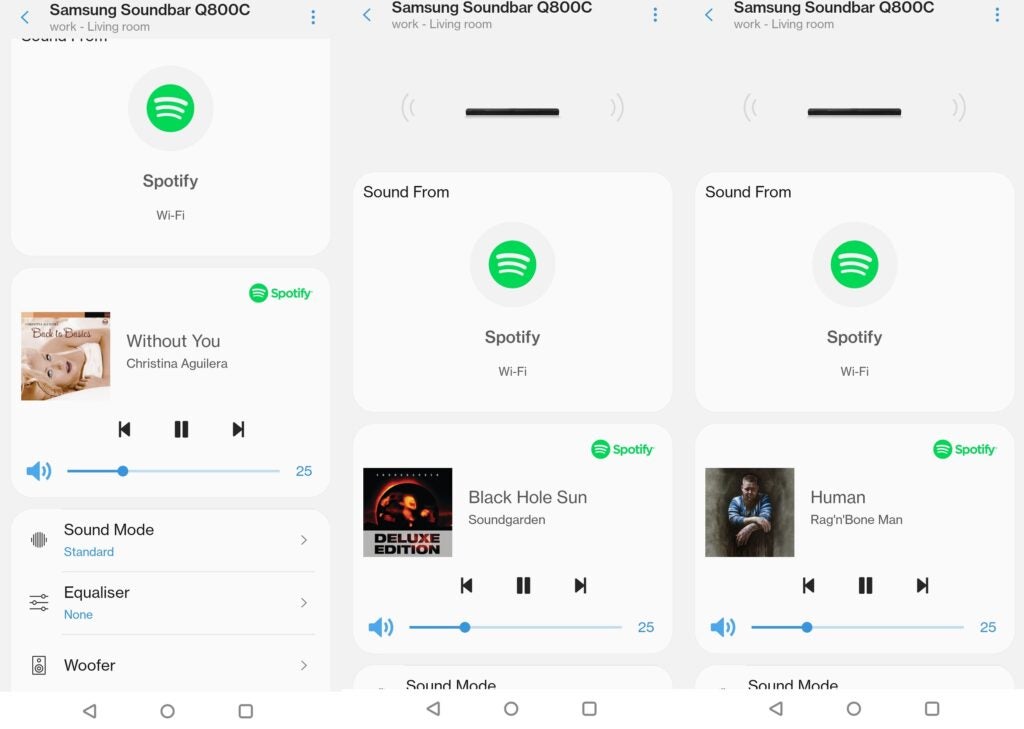
Latest deals
Should you buy it?
If film night is every night
You’ll want to hear your favourite films and TV shows at their best, and with impressive clarity, naturalism, good dialogue reproduction and big but controlled bass.
If you want surround speakers too
The Samsung HW-Q800C is a great option if you don’t have room for rears, but if you do, the HW-Q930C can be had for less than the Q800C + surround speakers combined.
Final Thoughts
The one aspect I wasn’t as ecstatic about the HW-Q800B was its bass performance, as it was too overpowering in some respects. Arguably the Samsung HW-Q800C suffers from the same complaint but only when cranked the volume up to unnecessary levels. You won’t need to do that, it’s plenty loud enough.
It’s yet another satisfying immersive soundbar from Samsung, perhaps not as exciting or as immersive as the one-box Sennheiser Ambeo Soundbar Plus, but not as expensive and it comes with a subwoofer whereas it’s optional with Sennheiser.
The lack of Chromecast is a puzzling omission considering the step down HW-Q700C features it, but the overall performance is excellent, and a step up from that bar.
The only thing that gives me pause is the price, which at the time of review is close to the HW-Q930C that includes rear speakers for a true immersive experience. That said, if you don’t have space for rear speakers, the HW-Q800C is another talented, cinematic soundbar treat to enjoy from Samsung. Check out our Best Soundbar guide for more options.
How we test
We test every soundbar system we review thoroughly over an extended period of time. We use industry standard tests to compare features properly. We’ll always tell you what we find. We never, ever, accept money to review a product.
Find out more about how we test in our ethics policy.
Tested across several weeks
Tested with real world use
FAQs
There’s no Chromecast support for the HW-Q800C, but in a weird quirk, there is Chromecast on the cheaper, step-down HW-Q700C.

